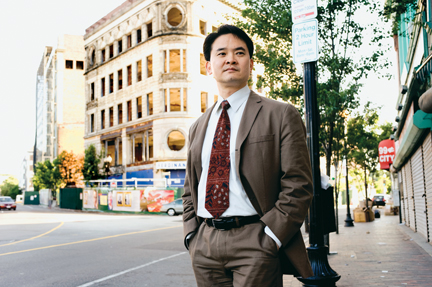City View
An open-minded perspective guides Kairos Shen ’87 in planning Boston’s architectural future.
 It’s dusk as Kairos Shen ’87 takes in a panoramic view of Boston’s harbor. “I can see the Custom House Tower, the airport, the new Rose Kennedy Greenway parks, the steeples of the North End, the Bunker Hill Monument, and the spires on the Leonard Zakim Bunker Hill Bridge. It’s a spectacular view,” he says.
It’s dusk as Kairos Shen ’87 takes in a panoramic view of Boston’s harbor. “I can see the Custom House Tower, the airport, the new Rose Kennedy Greenway parks, the steeples of the North End, the Bunker Hill Monument, and the spires on the Leonard Zakim Bunker Hill Bridge. It’s a spectacular view,” he says.
The view from the ninth and top floor of Boston’s City Hall comes gratis with his job as chief planner for the city. Shen was appointed to the position in January 2008 by Mayor Thomas Menino. Shen is also director of planning for the Boston Redevelopment Authority, where he has worked for 15 years and been director for seven.
Shen, who obtained a master’s in architecture from MIT, says he doesn’t have a single vision for the city’s future buildings: “Any great city has to embody multiple visions in terms of architectural style and expression. That’s how you get richness. We’re lucky [in Boston] because of the way the land and districts were developed. Historically, there were predominant ways of building, with predominant use of materials and heights that give a consistent fabric. Brick provides a backdrop here with more contemporary materials offset against that backdrop. I don’t think you can say, ‘this is what buildings ought to look like,’ and apply them. A principle I abide by is to be open-minded,” says Shen, who was born in Hong Kong to parents of Chinese ancestry and received U.S. citizenship in 2003.
Although always careful to ensure that his personal taste in architecture does not affect his job to approve, deny, or ask for changes to a proposal, he does let his preferences show in the office furniture. An avid chair collector, he brought in a Charles Eames chair and a Hans Wegner chair.
“Our job in the planning office is to make sure a proposal for a building acknowledges and respects its place within the larger urban fabric and supports and contributes to the city’s urban life and character,” says Shen, sitting in his Aeron desk chair that was made by Herman Miller and designed by Don Chadwick and Bill Stumpf.
“My colleagues and I have developed a set of principles that seem to work pretty well. A colleague of mine can start a design and development review process, and I can join in later and be following the same themes my colleagues pursued,” says Shen, who was a lead planner of the South Boston Waterfront, the Boston Convention and Exhibition Center, the preservation and additions to Fenway Park, and Harvard’s new Boston campus.
Shen says an average day’s work consists of a plethora of meetings inside City Hall with developers, planners, architects, and community activists; numerous phone conversations; and almost daily meetings with Mayor Menino in his fifth-floor office. About twice a week, Shen attends community meetings to listen to citizens’ comments on upcoming plans. He says he prefers these face-to-face interactions, waiting until around 6 p.m. to answer e-mails or review drawings. He tries to leave the office for home by 8 p.m.
He shares that home with wife Christine Pilcavage, an international development and public health adviser. They married last June at the Saarinen Chapel on the MIT campus. “We planned the wedding together. I designed the wedding invitation, which included an abstract drawing I created of the Harry Bertoia sculpture behind the altar in the MIT chapel,” he says.
To take a break from his job, Shen spends time working on a summer home in New Hampshire, which he and Christine share with Mike Miele ’87, Shen’s freshman roommate, and his family. Shen and Miele maintain a strong friendship.
When Shen walks the streets of Boston, he reminds himself that each of the structures around him is an artifact. “You can learn something about the culture, the building process, the client, and the architect, even if you only encountered the building, and never saw the drawings or learned how it was built. Some buildings deliberately negate or reject their role in the city, others embrace it,” Shen says. “But to know that this artifact was constructed and built according to principles that were documented in drawings, makes architecture very objective. There are many objective criteria you can use to evaluate architecture as good or bad.
“If people criticize a decision I make on behalf of the public, instead of hearing people say, ‘Mr. Shen is just exercising his opinions,’ I prefer to hear, ‘Mr. Shen is exercising his judgment that is based on a body of knowledge.’”
 Email This Page
Email This Page